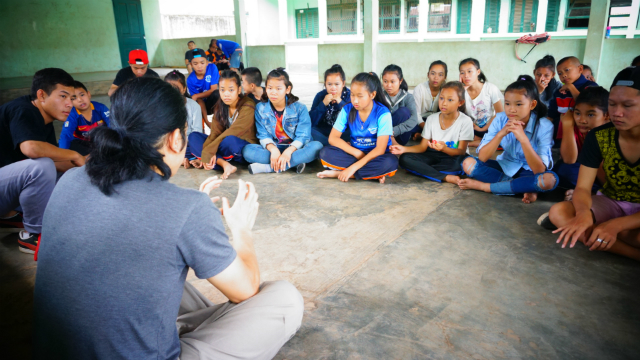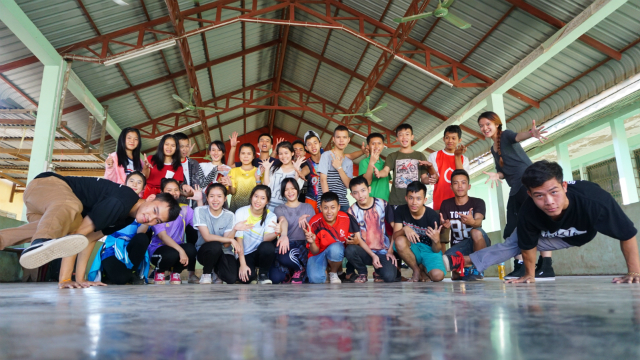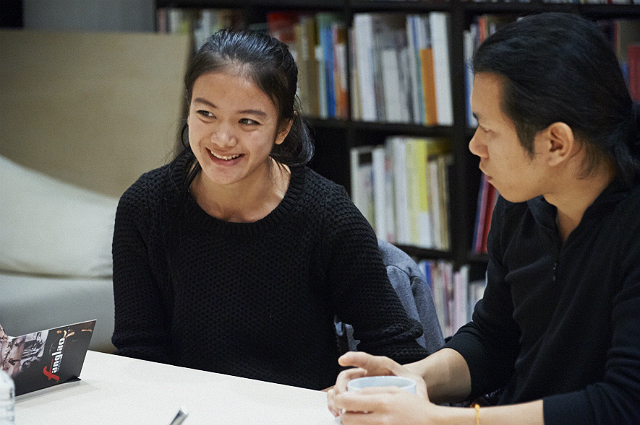
ASIA HUNDREDS is a series of interviews and conference presentations by professionals with whom the Japan Foundation Asia Center works through its many cultural projects.
By sharing the words of key figures in the arts and cultures in both English and Japanese and archiving the "present" moments of Asia, we hope to further generate cultural exchange within and among the regions.
Hip-hop Culture in France and Laos
Muto: Until now, it seems there has been little exchange between Laos and Japan, at least in the field of dance. In fact, this is probably my first time to meet people from Laos. What made your visit to Japan possible?
Olé: It was the Dance Dance Asia tour in 2015 where dance performances were held in Vientiane in December*1. It was right after we finished the Fang Mae Khong International Dance Festival *2 , an annual international dance festival that we organize, so we were able to see the shows. We met people from the Japan Foundation Asia Center, and they invited us to Performing Arts Meeting in Yokohama 2016 (TPAM 2016).
*1 Dance Dance Asia—Crossing the Movements is a project that supports exchange and co-production in Asia through street dance organized by the Japan Foundation Asia Center and PARCO Co., Ltd. It has been held in various cities since January 2015. In December 2015, Hilty & Bosch, Memorable Moment, and AREA ROCK STYLER from Japan performed and offered workshops in Vientiane.
*2 The first international dance festival in Laos organized by Company Kham and Fanglao Dance Company held almost annually since its foundation in 2010.
Muto: Did you take part in Dance Dance Asia too?
Olé: Yes, we, the Fanglao Dance Company, performed a segment from our new piece, Fang Lao.
Muto: What did you think of Dance Dance Asia?
Olé: There are not many dance events like this in Laos, so dancers coming to Laos from abroad to perform or bringing in something new to the local dance scene itself is stimulating. In the Vientiane edition of Dance Dance Asia, three groups from Japan, Fanglao Dance Company, and another group from Laos performed. Their articulation, I felt, was very eloquent and movements diverse. There was also a famous pair who is street dancers.
Muto: Hilty & Bosch *3 ?
*3 A duo of Jin and You formed in 1997. Based on locking, their dance has been acclaimed internationally.
Olé: Yes, they are internationally known. Their performance was full of variation and fun to watch. Not only break dance, but we also saw contemporary and jazz dance. In Laos, traditional dance and break dance have developed, but contemporary dance, ballet, and jazz dance hardly exist. We were so excited.

Muto: Since when have you been based in France?
Olé: Since I was two years old, so I've lived in Lyon since 1980. My mother moved to France with my sister and me, but my father stayed in Laos.
Muto: Are there many Laotian immigrants in Lyon?
Olé: There are many in Lyon, and in Paris, too. Laos used to be a French colony, so there are many things that are reminiscent of that period: we have French bread, and pétanque (a ball game originated in France) is even the national sport of Laos.
Muto: The national sport? (surprised)
Olé: Hard to believe, isn't it? (laughs)
Muto: Why did your mother decide to move to France?
Olé: I think she thought growing up in Laos wasn't the best for us given the political situation at that time. I think I'm more French than Laotian. But some of my relatives live in Laos, so I am strongly interested in Laotian culture and people. That's why I've been visiting Laos since 2006, about three times a year. I don't go there on vacation but to share various things instead. And since I am a dancer and choreographer, I thought I would build a sustainable relationship with Laotian artists.
Muto: Did you encounter dance in France too?
Olé: Yes, I did. Just like many other people, Michael Jackson got me into dance first. I imitated him obsessively. But, I came to want to learn more, and the most easily accessible was hiphop culture and street dance. I think I was 14 years old; there was someone who street dance in my neighborhood, and, since it was free, I started to study with him. It was Old School: breaking, locking, and popping. Now, there is New Generation that has emerged, but in my generation, it was Old School. From there, I wanted to further learn other styles of dance, so studied under contemporary dancers and choreographers in France and Italy. I have been studying capoeira since 2006, Laotian traditional dance, and Thai Khon (classical mask dance) too.
Muto: When you started break dance, were there many others like you?
Olé: There were. At first, we would gather around one teacher, but soon after we started to pursue and develop our techniques ourselves. There were French, Laotian, and also Arabic and African people; we had many foreigners in the neighborhood. Wherever we found a flat surface―whether it be at a community center, the back of a store, or a station―we would practice.

Muto: Could you say that hip-hop culture was a kind of common language in such a multinational environment?
Olé: It was. At first, it was a common language for people in Lyon. But now the scene has become bigger and much more open. The street dance scenes in Europe are very different from those in Asia. As it is well known, hip-hop emerged as a [sub]cultural movement in the early 1970s in America, specifically in South Bronx in New York City. As part of their territorial dispute, residents employed rap music, b-boying, and graffiti art, which were all artistic variations of their expressions of rivalry. Ten years later, hip-hop culture made its way to France and other European countries, where it, again, became popular as a means for people to express themselves within their communities. I think this is one example where culture took on a social role. Attributed with meanings related to issues of society, race, and exclusion, hip-hop culture became widespread among the marginalized communities. The diverse elements that is manifested in hip-hop culture―including break dance, graffiti art, rap music, and also fashion―made it easier for people to find their own, individual means of expression.
On the other hand, in Asia, in Laos for example, break dance is not for young dancers to express themselves. They do it because it is cool. Break dance involves spectacularized techniques, such as the headspin, which are seen as examples of American culture, and, thus, are considered "cool." The young dancers are always looking for something new. In Asia, the problem of young people lies elsewhere. For example, when I first visited Laos to meet break dancers, I noticed that they were all from wealthy families. Why? That is because children from less fortunate families don't have the time to practice. They don't learn about things on the Internet either. I thought that was a big difference.
Muto: You mean hip-hop culture is for the rich in Asia, while it is for the socially marginalized in Europe?
Olé: Yes, exactly. However, I must say that the situation has gradually been changing. Hip-hop culture has gained the interest of various generations throughout different classes in society and the genre is becoming more and more open to a wider demographic. In Europe, break dance from its initial stage was widespread: it existed throughout the cities and rural areas. But break dance in Laos was very different: at first, we worked with dancers from the wealthy class, then we wanted to include people from other classes, so tried to introduce break dance into schools because children go to school regardless of their class. We thought we would be in touch with society as a whole. We hold workshops every year at five schools in Thakhek County, located in Khammouane Province in south-central Laos. We teach every week for six months, and hold a competition toward the end of their term in March.
Muto: How did you negotiate with the local governments and schools?
Olé: There is a decentralized cooperation agreement*4 between Khammouane Province and the Rhône-Alpes Region in France, so it was relatively easy for my company Company Kham, which is based in France to be accepted. But at first, I must say, there was hardly any support: the agreement was only for education, irrigation, and medical service. We explained to the Rhône-Alpes Regional Council about our ideas about school workshops on hip-hop and how the locals are very interested in it, and they were very understanding. Now, cultural exchange has become part of the program, and we receive support from French and Laotian local governments. This was all possible thanks to the relationship between the regions. Sometimes, surprisingly, politics gives birth to new opportunities.
*4 he Rhône-Alpes/Khammmouane decentralized cooperation agreement helps provide institutional support for rural development. This includes improvement in education, health, cultural exchange, gender equality among others.


Traditional Dance and Break Dance
Muto: In the beginning of this interview, Olé said that traditional dance and break dance have both developed in Laos, which I found very interesting. Nout, am I right to say that the old and the new coexist and you both have been connecting them within the context of contemporary dance?
Noutnapha (hereinafter Nout) : Well, I started to study Laotian traditional dance at school when I was around six, and then I encountered hip-hop culture when I was 15 years old, in 2006. Back then, people in Laos were only familiar with "B-boy" and break dance, and did not really know about hip-hop as a larger culture. We were calling "B-boy," "hip-hop." Break dance for me, began when Olé came to Laos and I learned many different styles from the workshops. I encountered contemporary dance then, too. For me, contemporary dance is Olé since he is also the one who founded the Fang Mae Khong International Dance Festival.

Olé: I met Nout when I was on a residency program in Vientiane. Institut Français invited me to a one-month residency program to work with locals, during which time I held break dance and contemporary dance classes. The participants were mainly break dancers but it was for them to improve their techniques and also to expose them to ways of combining different genres; mixing hip-hop culture and Laotian traditional dance to create contemporary pieces, for example.
Muto: You spoke about trying to spread break dance to a larger social demographic. Could you accomplished that for traditional dance, do you think? I think traditional dance once had a certain social function, but do you think that has declined and been replaced by hip-hop culture and street dance?
Olé: No, that is not necessarily the case. This was an important point for when we explained our ideas to government officials too: we don't intend to replace traditional dance with street dance. We simply presented the fact that young people are interested in new methods of expression and that there are many ways to fuse different genres; that it is possible to create the new while maintaining the traditional.
Muto: So they coexist.
Olé: Yes, absolutely. When we teach at schools and organize the dance festival, we present Laotian traditional dance, too.
Muto: What do you think are the differences between traditional dance and street dance in terms of their social function?
Olé: Street dance used to be regarded as something foreign and unfavorable; the authorities and adults were not fond of it. Recently, though, people began to realize that the younger generation are deeply absorbed into street dance, and those who are absorbed into the dance don't get involved in bad things. Witnessing this phenomenon, the government has finally begun to accept it. Just like sports, street dance can guide the younger generation out of bad influences.
Nout: We also invited parents and people from the authorities to our workshops and explained to them how and with what sort of training one can become a professional dancer.
Olé: Dance is a good tool for developing one's creativity and sense of cooperation. If there are ten people, you can form a group and practice together after school and perform in events like ours. The festival we organize is precisely to create opportunities for young people to practice and perform with one another.
Muto: I guess you could even say that street dance has taken the role folk dance traditionally took in the past.







